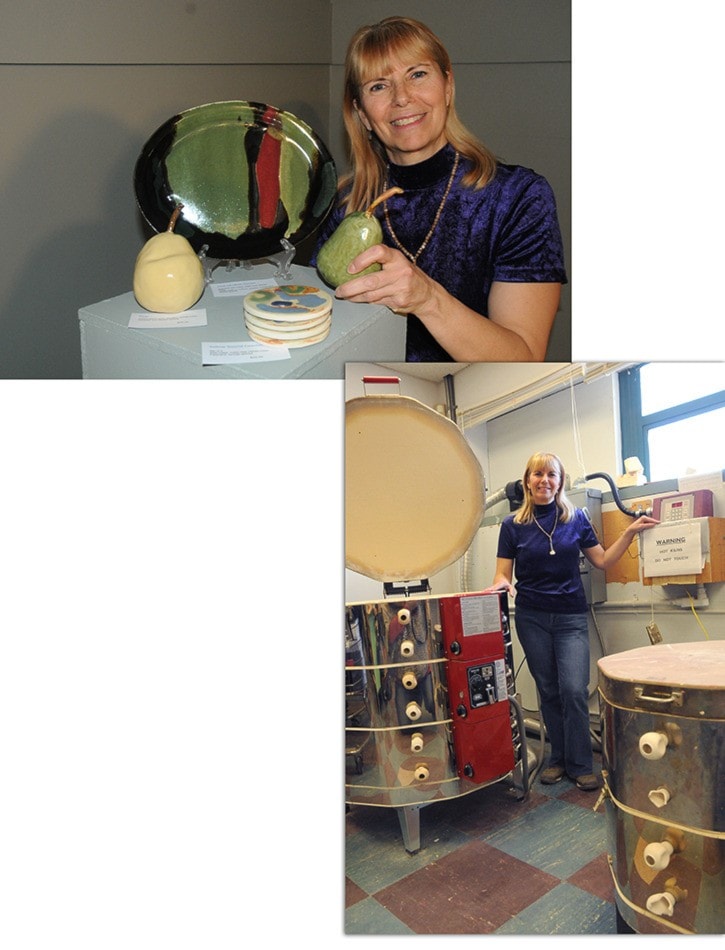If sandy beaches aren’t foreseeable for this year’s spring break, a local gallery is stirring the pot and showcasing work by those who have found fun with mud.
“Pottery: Follow the Process” is the VISAC Gallery’s current exhibit of works by nine of the area’s finest potters and open to the public Tuesday through Friday from 10 a.m. until 4 p.m. and Thursday from 10 a.m. until 6 p.m. until April 4.
One of those potters is showing for the first time since a cross-country move from a Toronto suburb landed her in the West Kootenay less than a year ago.
Heather Hurst, a 30-year potter and glaze technician, and her husband photographer Gary Drouin, followed their son westward to the mountains after retiring from big city life last summer.
Even though the 4,000-kilometre move induced a bit of culture shock, connecting with the art community was simple and only a click away.
“Nowadays, it’s very easy to connect,” said Hurst. “We found the VISAC Gallery on the Internet and toured the pottery studio and was impressed by what it had to offer.”
Hurst considers herself a hobby potter, and became interested in clay techniques and glaze texture as a child, after mixing vials of coloured mediums at an old roll-top desk her dad had refurbished for her.
“Time would just slip away and the same happens now when I work with clay or mix glazes,” she said. “Pottery is such a tactile medium and clay offers a great deal of variety. There are so many techniques to explore, ideas to try, glaze colours or textures to experiment with and combine.”
Beginning with an idea, a potter uses the subtlety of the clay body being used, such as how much it will shrink, how quickly it dries, and how elastic it may be.
Skills are developed to “throw” a form on the potter’s wheel or to sculpt a shape by hand, before the piece is bisque fired then glazed.
“There are many ways to glaze for the final firing,” explained Hurst. “One needs to know how the glaze will react in different temperatures, how soon it will melt, what colour it will be, or the texture of the surface. So many things can make or break a piece.”
VISAC’s exhibition combines almost 60 one-of-a-kind clay pieces priced between $5 and $100, including teapots, plates, and decorative items.
Admission is by donation and all visitors are welcome to choose a clay tsotchke from the small items table.
Some of the potters are self-taught while others have taken classes and workshops, although most, like Hurst, understand that the “kiln gods” can be cruel.
The gallery included a “blooper” table, which is work that has exploded, imploded or cracked during the temperamental firing of the kiln.
A recent disaster is the first piece of fruit, a pear, Hurst sculpted, that shattered in the Trail Pottery room’s kiln and now, those pear-like shards are displayed on the flub-up table.
“Fortunately for me, it only chipped another member’s bowl and she was most understanding,” explained Hurst. “It’s one thing to risk your own efforts but I would have been mortified if my impatience had destroyed someone else’s piece.”
Being a new resident, Hurst continues to integrate herself into the art community and adjust to life in the West Kootenay.
“I love the winding roads and how temperate the climate seems to Ontario,” she said.
“The only thing I struggle with here is scale,” Hurst explained. “It seems like absolutely everything is huge.
“We are constantly dwarfed by rocks and trees that are so tall or have diameters of small vehicles. Why, even the pine needles here are gigantic.”
